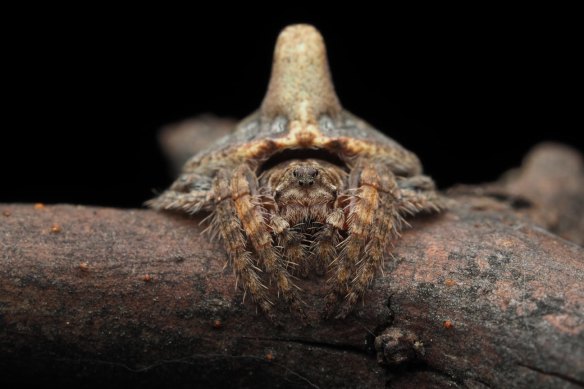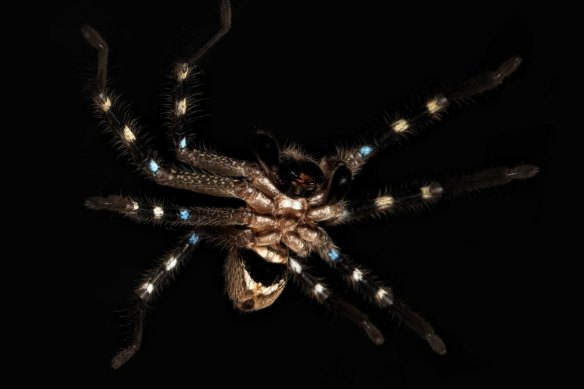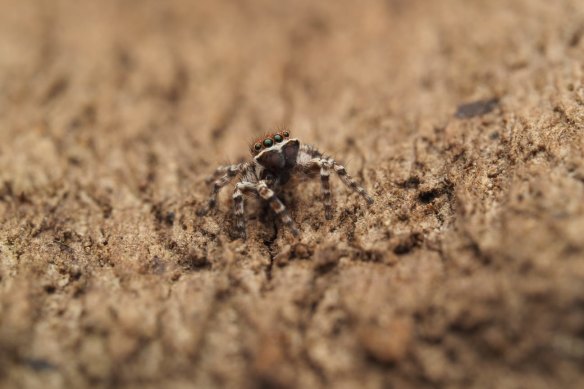Key points
- Three new species of spiders have been discovered by Australian scientists in the Alpine region.
- They include a warrior huntsman with a shield on its chest and a wraparound spider that impersonates a tree branch.
- The other is a jumping spider which bears a resemblance to a liquorice all-sorts lolly.
Arachnologist Joseph Schubert is one of a handful of scientists who have spent days in Australia’s Alpine region searching for new spiders.
It’s not an easy job, but Schubert, from the Museums Victoria Research Institute, and his team have discovered three new spiders, including one that looks like a liquorice-all-sorts lolly.
Scientists have discovered three new spiders in the Alpine region, including a wraparound spider that impersonates a tree branch.Credit:Joseph Schubert
The other two are a warrior huntsman with a shield on its chest and a wraparound spider that impersonates a tree branch. But Schubert said the team still wants to find more before the Alps Bush Blitz expedition comes to an end.
“Most people associate spiders with the outback dunny door, but spiders are hugely diverse. From the infamous shield huntsman with war paint on his legs and a shield on his chest to frighten off predators, to the tiny jumping spiders that look like eight-eyed puppies,” he said.
“Spiders are also experts at camouflage. The wraparound spider is a ferocious nocturnal mini-hunter that impersonates a tree branch during the day to hide from predators.”
The Alps Bush Blitz expedition boasts 15 scientists including botanists and zoologists from Parks Australia’s National Seed Bank in Canberra, the Australian Museum, the Museums Victoria Research Institute, the National Herbaria of NSW and Victoria and the University of New South Wales.
The warrior huntsman spider has been discovered for the first time.Credit:Joseph Schubert
The blitz is a partnership between the Australian government through Parks Australia, BHP and Earthwatch Australia.
Environment Minister Tanya Plibersek said there was still a lot of biodiversity that had not yet been discovered yet.
“Programs like Bush Blitz are giving us a deeper understanding of Australian habitats so that we can make nature-positive decisions for the future,” she said.
Australia has around 2000 flora and fauna species on the threatened list, which means they are at elevated risk of extinction. There are now more foreign plant species than natives growing wild and in the past five years, 17 mammal species were either added to the endangered list or upgraded to the critically endangered list, as well as 17 birds and 19 frogs.
The smallest of the newly discovered species is a three-millimetre jumping spider that looks like a liquorice-all-sort. Credit:Joseph Schubert
Plibersek has previously announced that there would be zero new extinctions of animals.
ANU ecologist professor David Lindenmayer said climate change and continued habitat destruction could result in animals dying out before they can be discovered.
“Some of the most important biodiversity areas are on the edges of urban fringes, so they are under enormous pressure,” he said. “It’s not a surprise that new species turn up all the time, that is pretty common.”
One way to ensure undiscovered species are given the best chance of survival is to map biodiversity hotspots and ensure development does not occur in those areas, Lindenmayer said.
Get to the heart of what’s happening with climate change and the environment. Our fortnightly Environment newsletter brings you the news, the issues and the solutions. Sign up here.
Most Viewed in Environment
From our partners
Source: Read Full Article





